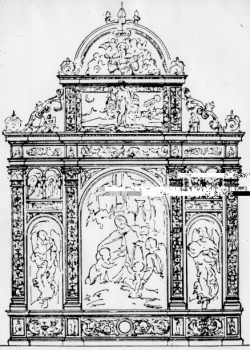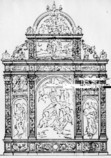Historical Details
In April, 1483, the Brethern of the Immaculate Conception commissioned Leonardo and the DePredis brothers to paint an altarpiece for their Chapel, San Francesco il Grande, located in Milan.
The painting, which would be installed in an elaborately made frame; also part of the commission, was to be the Virgin of the Rocks (Louvre), which Leonardo completed between1483-86.
In about 1490, the DePredis brothers, still working on the project, appealed for additional payment; pointing out that the Virgin’s painting had been completed but the frame alone cost the entire 800
lire fee to which the artists had originally agreed. They requested that the “oil painting of Our Lady” (Virgin of the Rocks) be withdrawn from the commission as others had offered to purchase
it. The petition was denied. In 1503, Ambrogio De Predis tried again and the case was dismissed.
It is not clear whether the Louvre work was hanging in the Chapel or was in Leonardo’s possession during the years of legal wrangling. Documents pertaining to the final settlement in 1506,
however, specified that Leonardo was to finish, or have someone else finish the painting with two years. For this he would receive 200 lire. Thus one version of the disjointed history of
the two works would have it that Leonardo finished the Louvre painting in 1486 and received no compensation for it as late as 1506 while the second painting was started in about 1503 and was finished
by 1506. The latter painting now hangs in the National Gallery.
Other accounts theorize that the Louvre work was hanging in the Church of San Francesco il Grande in 1503, but that groundwork of a copy was in the DePredis workshop. In 1506, the year the
matter was settled. Since Leonardo had not been paid for the first painting, it was forfeited to him, and he in turn, gave it to the King of France. At the same time, for one half the
original payment he had been asking for the original version, Leonardo gave the Confraternity the groundwork, which he agreed to finish in two years. Angela Ottino della Chiesa1 argues
that this is the London version.
The Louvre version was first mentioned as part of the royal collection at Fontainebleau in 1625. The London version, which remained in the church of San Francesco il Grande in Milan until 1781,
was taken to the hospital of Santa Caterina in Milan and purchased in 1785 by the English painter Gavin Hamilton. It was in the collection of the Marquis of Landsdown, then the Earl of Suffolk,
before entering the National Gallery in 1880.


